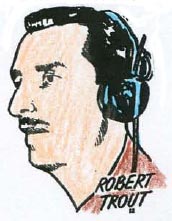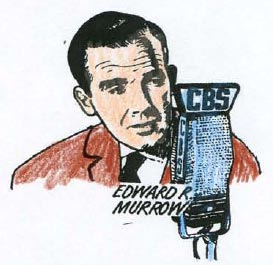|

This story was published in Radio Recall, the journal of the Metropolitan Washington Old-Time Radio Club, published six times per year.
Click here to return to the index of selected articles.
|
|
 BIRTH OF THE NEWS ROUNDUP BIRTH OF THE NEWS ROUNDUP
by Brian Rogers © 2010
(From Radio Recall, April 2010)
At 8 p.m., New York time, on Sunday, March 13, 1938, newsman Robert Trout told listeners on the Columbia Broadcasting System (CBS) radio network, “A program of St. Louis blues originally scheduled at this time has been canceled.” What followed Trout’s announcement was the first use of the format still known as the “news roundup.” (CBS Radio’s twice-daily World News Roundup is America’s longest running news program.)
What circumstances led to this historic pre-empting of a St. Louis blues music broadcast? Blame a short, Austrian-born German named Adolf Hitler, who, in March 1933, had been elected chancellor of Germany. Soon his Nazis dominated the Reichstag legislative body.
Prior to the late 1930’s, radio was primarily an in-home entertainment medium. While it had a huge ability to bring the events of the day into countless homes, it chose instead to present much lighter programming. Audiences were treated to ex-vaudevillians such as George Burns, Gracie Allen, Jack Benny and Al Jolson. And there was drama and continuing serials such as Little Orphan Annie and Buck Rogers.
Program sponsors had concluded that listeners preferred diversion from their Great Depression anxieties and were thus reluctant to pay for news programming. Hitler helped change that.
Three days before the historic broadcast CBS newsmen Edward R. Murrow and William L. Shirer were otherwise occupied. Murrow was in Warsaw, Poland, to broadcast a chorus of schoolchildren, while Shirer was in Yugoslavia to do the same with an ensemble of miners’ children.
Murrow, born Egbert Roscoe Murrow, in a log cabin at Polecat Creek, North Carolina, on April 24, 1908, and grew up on the converging cusp of two great events: the rise of radio and the descent of Europe into war.
CBS had hired Murrow in 1935, when he was 27, as its “director of talks to coordinate broadcasts on current issues.” He did not broadcast himself but found people knowledgeable on various subjects and issues to do so.
Shirer, born in Chicago in 1904, had been a print reporter for such publications as the Chicago Tribune, Paris Herald , and the New York Herald Tribune. Murrow, looking for someone to coordinate talks from the European continent as he was doing based in London, hired Shirer in August 1937.
When Shirer came to Vienna, Austria, from Yugoslavia on March 11, 1938, he found the city in turmoil. The conflict between Germany and Austria was boiling regarding whether Austria would become part of Hitler’s Third Reich. As an Austrian native, Hitler had long wanted to add his homeland to his Reich. The move became known as Anschluss.
The only American radio newsman in Vienna that day, Shirer tried in vain to tell the story to his network. He was dependent on state-run short-wave facilities to get the story to CBS, and Nazi officials who had taken control refused to let him on the air. They eventually escorted him from the building at bayonet point.
When he reached Ed Murrow in Warsaw, Murrow suggested he fly to London and report from there, while Murrow would travel to Vienna. Both men passed through Berlin on their journeys.
Shirer reported from London as planned and CBS headquarters in New York wanted more. Network News Director Paul White phoned Shirer and asked if he and Murrow could coordinate a thirty-minute broadcast of reports from various European capitals, in effect a “news roundup.” Without thinking of how it would be done, Shirer eagerly replied yes.
The operation would be entirely new. Correspondents in such places as Paris, Rome and Berlin would have to be contacted and scheduled. Since there were, of course, no communications satellites in 1938, and CBS didn’t own any short-wave transmitters in Europe, state-owned facilities in various places had to be lined up. Then times and frequencies had to be cabled to New York to alert US monitors when to listen and feed the network. There was no such thing, then, as recording for later broadcast.
And News Director White wanted the broadcast that night at precisely 8 p.m., East Coast time when it was the middle of the night in Europe. To those involved the operation seemed awkward and clumsy, but listeners found it smooth and seamless. Shirer reported from London that a few protesters had gathered near the German embassy but that most Britons had taken calmly the news of the German annexation of Austria.
Murrow, speaking from Vienna, told CBS listeners that Austrians seemed in a holiday mood awaiting the next day’s arrival of Adolf Hitler. Other newsmen taking part were Edgar Mowrer in Paris and Pierre Huss from Berlin. A report from Italy had to be cabled to London to be read by Shirer, because no short wave transmitter was available.

(Illustrations by Bobb Lynes)
Murrow, who had been hired as a “director of talks” and not an on-air broadcaster, made his first broadcast that night. He went on to head CBS’s news team in Europe and became famous in 1940, when Germany was attacking London at night by air, for his spot reports that began “This ... is London.” The pause between the first two words of the phrase is said to have been suggested by Ida Lou Anderson, his speech instructor at Washington State College.
His reports from the British bomber “D for Dog,” on December 3, 1943, a piece that became known as “Orchestrated Hell” from Murrow’s description of the scene below, and the liberation of the Buchenwald prison camp on April 15, 1945, have become broadcast journalism classics. Fortunately, both exist on recordings.
He hired a staff or newsmen that became known as “The Murrow Boys.” Besides Shirer, they included such future electronic journalism giants as Richard C. Hottelet, Eric Sevareid and Charles Collingwood. One was a woman: Mary Marvin Breckinridge,.
What we now so take for granted in electronic reporting can be traced back to that Sunday evening in March 1938 when radio news showed us what it could do.
ABOUT THE AUTHOR: Brian Rogers, a retired teacher living in Allen Park, Michigan, recalls running home from school during World War II and listening to Jack Armstrong, Captain Midnight, and Hop Harrigan, Ace of the Airways. His main OTR interests presently revolve around news reporting. His writing about short wave listening has appeared in Monitoring Times.
|